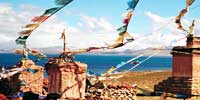
Mt Kailash (19:15) This text is replaced by the Flash movie.
Mt. Kailash in Tibet is one of the world's most venerated -- and least visited -- holy sites. Walking its circuit alongside pilgrims, yaks and yogis, we circle the center of creation. Debuted on Stories from the Heart of the Land.
Click thumbnail for more photos and text, courtesy and © Scott Carrier:






























